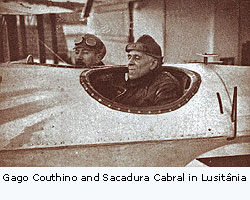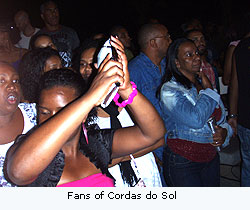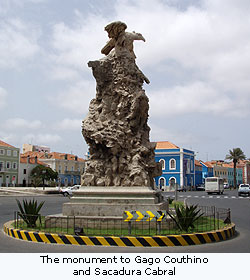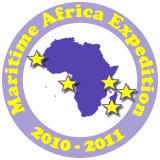
News: 2 Jul 2010, Mindelo | |
       
: | Although secure enough, the left luggage room at the ferry terminal wasn't the ideal place to keep the FIB because it is not the easiest place to get in to, and certainly not with the wing rigged, even off the machine. And there's no launching ramp, just a 2 metre drop off the quay. There was the option to keep it somewhere else at the port, but there didn't seem to be anywhere obvious, so Antonio and I went up to the airport to see if that would be better. As at Praia, they couldn't be helpful enough and found a suitable space in the old fire station for me. So this morning we loaded it on to a small truck and took it up there. After the normal performance with security we were escorted round to the fire station and I was left on my own to get the machine ready. The crew were in town filming a place which makes and sells guitars and cavaquinhos, a sort of ukulele, which are a significant sound in the local music. If it's windy in Mindelo town, it is super windy at the airport, which is set in a valley which seems to accelerate it like a venturi. I'm seriously wondering if we'll do any flying here at all, but you never know. Of course the more flying we get the better, but in the next 10 days or so there are two, or possibly three flights we want to do as a minimum. First, and least ambitious, is a flight along a beach at São Pedro, a fishing village practically at the end of the airport runway, and from where we (or rather Stéphane, at least for the film, but I'm definitely going too) will be going tuna fishing for the day. We went there yesterday afternoon on a recce. Being in the lee of the wind the water was certainly calm enough to land on but really quite a heavy swell directly from Brazil would make beaching in the surf very problematic so I think just a few fly-bys will be the thing. Second, a flight to land in Mindelo port. This is not very far either, very sheltered water, and would be quite fun as we'd be landing right in the middle of town and a large crowd is guaranteed. Close to where I will make my sea landing I found a rather extraordinary monument in a roundabout on the esplanade, a funny looking eagle standing on a huge pile of droppings. There are two plaques, the original one says: "Homage from the city of Mindelo to Sacadura Cabral and Gago Coutinho V-III-MCMXXII" which is I think 5 March 1922, but otherwise not very enlightening. The second one gives a better clue, and says "Association of Air Force Specialists, Cabo Verde section. Commemoration of the 76th anniversary of the first aerial crossing of the south Atlantic, Gago Couthino and Sacadura Cabral, Mindelo, 30 April 1998." So here we have something really quite interesting, this was, after all, only two years after Alcock and Brown were the first to fly the North Atlantic, and it was quite an adventure: Sacadura Cabral was the most notable Portuguese pilot of the time. Originally a naval cartographer he had learnt to fly in France in the first World War. He was appointed Director of the Naval Aviation Services in 1918, and Squadron Commander of the Aero Naval Base of Lisbon. He'd also been Aeronautics Attaché in both Paris and London and had made long flights like Calshot (the home of Fairey, near Southampton) -Lisbon, Lisbon-Funchal and Lisbon-Madrid. Gago Coutinho was also a naval navigator who had been in Africa with Cabral and they had mapped more than 500 miles of the Mozambique border together. He had developed a special sextant which used a water bubble to create an artificial horizon, and it was this device that made the long flight over water possible. The flight began in Lisbon on 30 March 1922, was supported by the ship República and had to be carried out in stages as a result of the limitations of "Lusitânia", their British made Fairey 3D floatplane, fitted with a Rolls Royce Eagle engine. Lusitânia was 'stretched' to accommodate additional fuel tanks in the original pilot's cockpit in the centre section and in the aircraft's floats. The Pilot was moved aft to the observer's cockpit and the 'observer' was moved rear to the gunner's position. The wing span was increased from the standard 45ft to 64ft span with 3 bays per wing. Fuel was pumped from the floats by wind driven impeller pumps. Sacadura Cabral in a letter to the Portuguese newspapers on the eve of the departure to Brazil wrote: "Any air trip is a question mark, and this one much more so, since it presents innumerous difficulties. I know the ‘pain in the neck’ it is, and I can say that there is a 50% chance of being concluded and the same percentage against it. The trip is possible, but it is necessary that everything run smoothly or, if you prefer, that the Eternal Father remain ´at least´ neutral in the fight between us and the elements. Let us hope it happens this way, but let us not crow before we are out of the woods... He isn’t always in a good humour." There were several delays and two detours from the original plan to fly via Las Palmas, Praia, Fernando Noronha, Recife, Salvador da Bahia, Porto Seguro and Vitoria to Rio de Janiero. The stop [here] in São Vicente was a deviation caused by fuel leaking from the floats, first observed in Las Palmas, and which may have been originally caused during take off from Lisbon. By the time they got to Praia it was obvious they could not make the 2300 Km to the Brazilian island of Fernando Noronha without stopping at St. Peter & Paul’s Rocks to refuel from the República, a distance of about 1700 Km. The weather at St. Peter & Paul’s Rocks in the intertropical convergence zone is notoriously fickle so the República went there and reported back to Praia by radio when they had good weather and sea landing conditions. Heavily loaded, they had several attempts before getting off the water at Praia, which of course also consumed fuel. Soon after they took off the República reported the weather had changed for the worse, but the pilots didn't know this, and in any case had more pressing concerns: Sacadura describes it in his report: "The wind continues to weaken and the fuel consumption remains, at least, around 20 gallons per hour. I again discuss our situation with Commander Coutinho, which seems to me to be very serious. We must be about 690 miles from the Rocks and we don’t have more than 8 ½ hours of fuel. To get there, we should make 80 miles per hour, and our speed is now 72 miles per hour! The logical, the prudent thing to do, would be to turn back, but the bad impression it would leave, if we did that, certainly would be enormous! I confess that, to me, this was the most bitter part of the Lisbon-Rio trip, because for 9 ½ hours I was never sure of whether or not we had enough fuel complete the trip. If that had happened and we had to alight on the sea, far from the Rocks, those who didn’t know us would always suppose that we had departed with enough fuel, but that we got lost and had alighted somewhere on the ocean, and thus what we had set out to prove would remain unproven, that is, that aerial navigation is susceptible of having the same precision as naval navigation!" They did just make it to the miniscule 4 Ha archipelago with just the smell of petrol remaining in the tanks, Manuel Maria Sarmento Rodrigues on board República described the landing: "One of the pontoons of the Lusitânia touched the ridge of a wave and was smashed to pieces. The plane still jumped and fell down heavily, nosing down, with the tail upwards! We froze still, dumb. A deadly anguish touched us deeply. Some tears were shed. Many people leaned back against the gunwales, exhausted, nerves all shattered. The vessels race towards the plane and, with difficulty, pull out its valorous crew. The heroes were safe, but the Lusitânia was lost. With deep emotion, Gago Coutinho goes up the stairs of the gangway of the ship República. He was looking at his plane, so loyal, so cherished! - That engine was our heart! Commander Sacadura, impassive, without leaving the gig, asked for a cigarette. And, without any other consideration, rowed toward the half submerged plane and tried to salvage it. Not a word or a gesture, of sadness or happiness. A man of steel! " As national honour was at stake, the Portuguese government immediately sent a similar Fairey 3F named "Portugal" in a Brazilian passenger-cum-cargo ship bound for Recife. Poor weather at Peter & Paul’s Rocks and the fact that the ships passengers wouldn't let them wait for more than two days for it to improve resulted in the aircraft being unloaded at Fernando Noronha instead, an island some 600 Km to the south west. To maintain a contiguous flight, they decided to fly from Fernando Noronha back to where Lusitânia had sunk, and then turn round to rendezvous with República in the open sea some 100 Km from Fernando Noronha, refuel, and continue on to Recife in Brazil. Five hours after take-off, the aviators saw St. Peter & St. Paul’s Rocks from about 15 miles, but heavy rain, to which the engine was very sensitive, made them decide to skip this short distance and turn back towards the ship. About 1 hour and 50 minutes later, the engine stopped "due to fuel carburetion hiccups" but they made a successful forced sea landing. They managed to restart the engine for some 55 minutes but before they could take off, the engine stopped again, this time never to restart. As the floats began to sink, one of the airmen had to sit on the engine to maintain its balance. This was probably the most desperate moment of the flight, Gago Coutinho later said "There was a small shark alongside a larger one. The bigger one was the father…He was bringing his son to teach him how to survive…When they realized that the plane wasn’t edible, they went away." Meanwhile, the República had realized something had gone wrong and sent radio messages to ships in the area announcing a probable incident. About 1 hour and 20 minutes later, when the two pilots hopes were "vanishing under fatigue and sleepiness", a distant light in the dark emerged to which they responded with two flares, and they were rescued by the British freighter the "Paris City" of the Reardon Smith Line under Captain A.E. Tamlyn, en route from Cardiff to Rio de Janeiro. A third Fairey 3D, similar to Lusitânia but unmodified, and named "Santa Cruz" was then shipped to Fernando Noronha in the Portuguese navy ship "Carvalho Araujo" and the flight was immediately continued to Recife, Salvador de Baia, Porto Seguro, Vitoria, finally arriving without any further major incident at Rio de Janeiro on 17 June. The Santa Cruz is preserved in the Museu de Marinha in Lisbon. A great story of pioneering aviation even if there was one small gap in the flight, and it took three different aircraft to do it. I was curious why the original plaque on the monument at Mindelo puts Sacadura Cabral before Gago Coutinho, while it is the reverse on the more modern one. Antonio, who knew both names as Portuguese national heroes couldn't answer this, but it was because Sacadura Cabral was the pilot while Gago Coutinho was the navigator, and it's usual to put the pilot's name first. However, Sacadura Cabral disappeared only two years later in a flight on 15 November 1924 over the English Channel, along with his co-pilot Mechanical Corporal José Correia, due to fog and his shortening eyesight "which never kept him from flying" whereas Gago Coutinho went on to become an Admiral in the Portuguese Navy, was showered with honours, died aged 90 in 1959 and was much better known for the flight in later years. Ultimately it doesn't really matter, the real feat was finding that tiny rock in the middle of the Atlantic, in poor weather, with equipment you had invented, just as you are about to run out of fuel. Back to our plans. I think I've persuaded Christian, who doesn't seem terribly interested in aviation history, that if we land on the beach in the port, we can walk the short distance to the eagle on droppings monument and I can tell Stéphane this ripping yarn (if I can keep it short enough). It was certainly a big event at the time, there is some British Pathe newsreel showing an absolutely enormous crowd welcoming the heroes back to Lisbon. My third flight is intended to be to Santo Antão, another island north of here. There's no airfield marked on the map but there is one at Vila Maria Pia on the north east coast. It is rather short and aligned across the formidable prevailing winds so only quite small aircraft like twin otters can use it, and then only sometimes. Cabo Verde Airlines doesn't have any suitable aircraft so the airfield is effectively disused for the moment, but we have a permission to go there anyway. It's only 40 Km from here across the 10 km channel between the islands so is theoretically quite easily attainable so long as the wind drops, but it isn't showing much sign of doing that at the moment. This evening we went to a most splendid concert by "Cordas do Sol" in what must be an Italian designed ultra-modern venue attached to the new marina in the harbour. They are Cape Verde's number one group and play traditional cavaquinho, guitar and drums with a modern twist, and the singer was great; "only 20 years old", Antonio said. The crew filmed it, but I hope they keep the embarrassing shots of me trying to be young and enthusiastic in the final edit to a minimum. Actually it was good fun, I was in a section of the crowd full of die-hard fans who danced along enthusiastically and knew every word to every song. I recommend their latest CD "Lume d'Elenha". References: http://en.wikipedia.org/wiki/Gago_Coutinho http://en.wikipedia.org/wiki/Sacadura_Cabral http://honeymooney.com/brazil/coutinho_cabral_summary.htm http://www.britishpathe.com/record.php?id=19666 http://www.britishpathe.com/record.php?id=18480 http://www.aviastar.org/air/england/fairey_3.php http://www.vidaslusofonas.pt/sacadura_cabral2.htm http://blogs.airspacemag.com/daily-planet/2009/03/30/across-the-south-atlantic-in-1922/ |
Home
8 Jul 2011, Video clips
28 Jun 2011, Message from the producer
17 June 2011, Postscript
27 Sep 2010, Dar again
23 Sep 2010, Chumbe
20 Sep 2010, Zanzibar again
18 Sep 2010, Bullfight
17 Sep 2010, Kervan Saray
16 Sep 2010, Pemba
14 Sep 2010, Nungwe
12 Sep 2010, Popobawa
11 Sep 2010, Zanzibar
9 Sep 2010, Teddy Junior
26 Aug 2010, Ursula
26 July 2010, Home
17 Jul 2010, Just in time
15 Jul 2010, No wind
13 Jul 2010, Mindelo again
11 Jul 2010, Grogue
9 Jul 2010, Ponta do Sol
7 Jul 2010, Goal
5 Jul 2010, Independence day
4 Jul 2010, Wind
2 Jul 2010, Mindelo
31 Jun 2010, SS Tarrafal
30 Jun 2010, Tarrafal
27 Jun 2010, Praia
23 Jun 2010, Sal
20 Jun 2010, Bonding in Munich
29 Apr 2010, Lake Trasimene
Mauritius
Wind
Cape Verde
20Kt wind probability
Zanzibar
Talks & Presentations
RMH pilot CV





